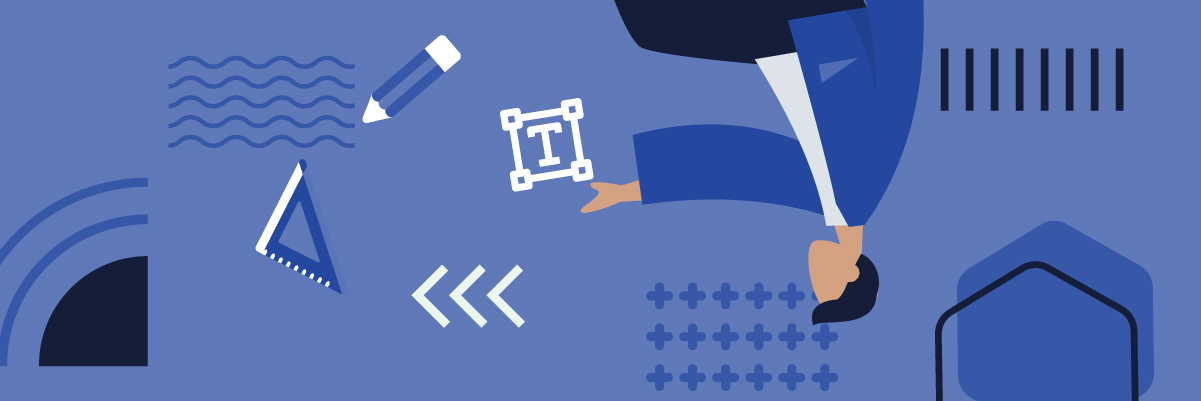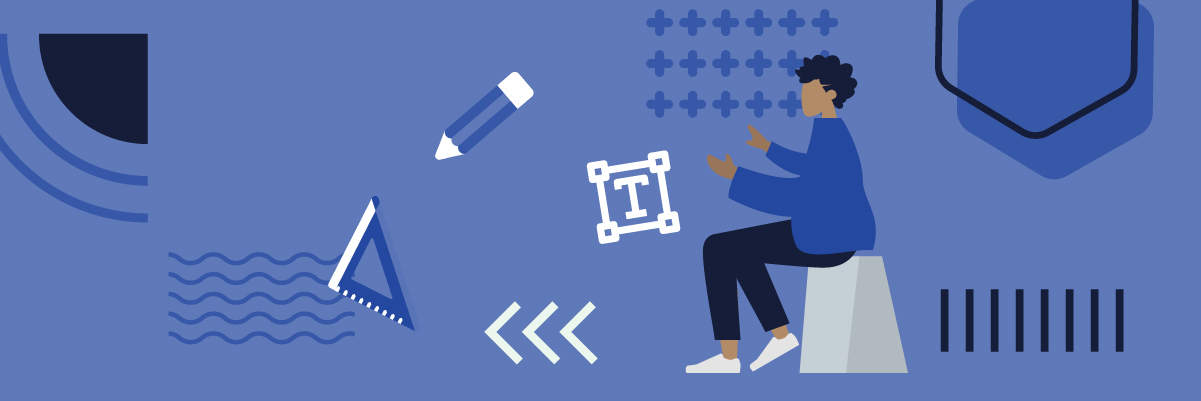An incontestable 70% of firms put their money on content marketing strategies involving graphics. As you struggle to reach your audience through the texts & audio, it’s criminal to ignore the role of pictures in branding and promotion. Hence, the importance of a graphic artist.
But why graphics? Don’t they seem outdated?
Graphics are visually communicated concepts. They create the first impression, attract your attention and deliver messages directly. Furthermore, a HubSpot study found social media content with graphics is liked and shared 3x than other marketing tools.
Generally, sending visual messages through drawings, animations, illustrations, and pictures enhances content comprehension and retention. For instance, your website visitors can capture quick facts from tables, pie charts, and graphs faster than they’d do from a paragraph.
So who are graphic artists? What can they do for your small business, and where can you find one?
In this discussion;
- Who is a graphic artist?
- Roles & responsibilities of a graphic designer
- How an artist can boost your business
- How much do they charge?
Who is a Graphic Artist?
Graphic artists use multiple media to express a particular idea or personality. Their communication design involves using visual elements to send messages.
These artists focus on making your brand stand out and capture attention at a glance. They also develop visual concepts physically or using computer software. You can hire them to help create informative and inspirational graphics for your audience.
The best graphics are achieved through:
- Pictures
- Animation
- Drawings
- Text
- Shapes
- Fonts
- Colors
- Logos
Business owners, therefore, develop an idea and then hire a graphic designer to help them execute it.
Once the client approves, the project is considered successful, and it is helpful for promotional purposes.

The Roles & Responsibilities of a Graphic Artist
Are you looking to hire an artist for your future campaigns? First, let’s understand their role and responsibilities to your small business.
Today, graphic design jobs involve blending art and tech to express concepts through the elements discussed above. In essence, they work on the layouts and designs for logos, flyers, adverts, newsletters, brochures, and business cards, etc.
These experts blend images and texts. For text-related or calligraphic projects, they choose the font type, color, size, placement, length, etc. Artists also do strategic editing to ensure that pictures and words appear harmoniously on a web page.
Other times, they help you arrange and balance texts to fit into specific layouts. They partner with content writers for such projects to achieve a viewer-friendly format, i.e., pie charts, infographics, tables, etc.
In a nutshell, they handle all design and administrative tasks, including:
- Schedule sessions with clients to discuss project details
- Offer insights on tactics to attract your target group
- Understand the message to convey with the design
- Develop pictorials that make your product stand out or delivers a message
- Design graphics for your web page, logo, or product demos
- Create designs either by hand or using computer software
- Decide the relevant color palette for your project
- Select the right images, font, and background
- Send the deliverable to your marketers
- Execute your recommendations into the final deliverable
- Double-check designs for mistakes before publishing or printing
Forward-thinking brands understand the role of graphics in the launching and promotion of products. Before hiring a freelancer, it’s crucial to inspect their skillsets and qualifications.
How a Graphic Artist can Boost Your Small Business
It’s difficult to argue with statistics. According to a Wyzowl study, web users recall only 10 percent of what they hear and 20 percent of their readings. There’s, however, a dramatic gap compared to what they see and do; 80 percent sticks!
Other studies show most internet users have short attention spans. The sooner you deliver a clear message and add a CTA, the better. With a “short and sweet” approach, you’ll likely convert more visitors into prospects (and prospects to buyers).
After all, a picture speaks a thousand words; graphics communicate to your audience in many ways. They sum up paragraphs of content into a simple, easy-to-digest illustration.
Discover more advantages below;
1. Engage your audience better
With graphics, it’s all eyes on the prize and, and all hands on deck. If 80 percent of the content people see sticks, then why not keep them scrolling. Thus, combine images and texts throughout the customer’s journey, whether on blogs, newsletters, videos, eBooks, at checkout, etc.
Visual elements can also increase visit times significantly. Even people who don’t like reading text can have a sneak peek by going through pictorials.
Remember, running a data-guided business is an excellent way to survive and thrive. Shoppers want the visual aspect of your brand; take advantage of that!
2. Pose as a Professional
A web user who winds up on your landing page checks its “appearance.”
‘Does it look good? If the first impression is crappy and you’re not Amazon, then bye-bye! Let’s check out other options– and that would be your competitors!’
You may have the best text and call-to-action and still lose to a competitor who’s only attractive and attention-grabbing.
Either way, the most prominent brands shine all the way: from their logos and landing pages to personalized emails and whatnot.
3. Consistency wins!
PayPal is blue and blue, McDonalds is yellow and red! Top brands insist that these color palettes appear across the customer’s journey. That way, they demonstrate consistency, stick to the client’s mind and earn their loyalty.
Graphic design is a big deal–so big that you must inform customers before doing a facelift or makeover. Plus, these facelifts shouldn’t vary largely from the previous theme. Even some loyal customers don’t visit your website every day. You don’t want to appear as someone else when a client comes a month later.
4. Evoke customer emotions
Emotion is the secret sauce in marketing. Tap into it, and you almost certainly have a prospect’s attention.
A picture is more likely to trigger an action, i.e., push one to share a post or make a purchase, than texts or narratives.
It happens to everyone every day; you scroll downwards until you a picture captures your attention.
Below are two strategies to evoke customer emotions:
- Focus on what your customers feel now.
Use graphics that resonate with your target market’s pain points.
Please prove that you understand their pain through photographs, animations, illustration, or text.
- Focus on the prize
Graphics that flaunt the prize without overly marketing the product can spark the right emotion.
Whichever strategy you choose, work with an expert from professional freelance platforms like Bunny Studio.
5. Reach a diverse audience
My grade 5 English may not be good enough to understand your paragraphs. Or your slang may sound like alien lingo to my 65-year-old grandpa. However, strategic images tend to make sense to the broader demography of people.
Similarly, it’s easier to relate to content from a foreign language if images accompany the text.
Don’t limit your potential. Speak to your diverse audience with intuitive graphics that resonate with “all and sundry.”
6. Break down workplace communication
Let’s say you wanted to introduce your recruits to the firm’s organizational structure. Would you choose a paragraph or hierarchy table?
Even workplace manuals and tutorials are easier to follow and understand if accompanied by graphics.
Pictorials sum up what would come out as fluff if written or presented as a video or audio file.
7. Brief customers of a change in service procedures
Making adjustments in the customer’s experience can confuse. Moreover, poor communication can escalate the situation into full-blown mayhem.
For instance, a simple change, e.g., is easier to understand as presented below;
We’ve Updated Our Service From:
Signup>>Trial>>Approval>>Subscription>>Services
To:
Signup>>Subscriptions>>Bonuses>>Services
The mere use of arrows to indicate what comes next is just an example of how graphics simplify content comprehension. This breakdown also communicates the specific changes at a glance.
Add strategic images, brand logo, attractive fonts, a relevant color palette, etc., and you’re ready to go!
8. Stand out among competitors
Standing out from the crowd is easier than done! Yet one common trait among all high-end brands is creative graphics.
It’s okay to test your graphic design skills with the many DIY tools. But you stand a better chance working with an expert visual artist. Hence, sharing ideas with a professional designer opens new perspectives and yields desirable results.
With companies going gangbusters with their marketing campaigns, it’s crucial to search for the X factor.
Famous Graphic Artists
Great names hide behind the many famous design work we see every day
Below, we present 5 of the most famous artists and their portfolios.
o Chip Kidd, a.k.a. Alfred A. Knopf. (The king of book covers)
New York’s Kidd is the king of book covers. He is also the artist behind Jurassic Park’s attractive cover. Kidd has executed similar projects for many other authors.
o Rob Janoff (The apple bite)
Janoff is the reason a bitten apple is the image behind the world-famous computer company Apple Inc. According to him, the project was a “no-brainer.” Simple as the concept sounds, the logo remains popular. Apple only improved it with a color palette.
o Marta Veludo (Queen of the shoe brands)
Amsterdam-based Marta Veludo is a dynamic artist whose works speak for her. Her top-rated projects include shoe-brand logos for Adidas and Reebok. She is also the designer behind Vice and LEGO’s logos.
o Alex Trochut (Coca-cola Alex)
The Barcelona-born, NY-based Alex Trochut is a master of illustrations and typography. His talent won him a job with big names like Nike, Coca-Cola, and Apple.
o Will Bryant (A Jack of all trades)
Texas-based Bryant is a jack of all trades and the wizard of popping colors. He can execute fun projects like Nickelodeon and still work for digital clients like Google and Dropbox.

Graphic Artist: How much do they Charge?
Lots of factors determine how much you pay for freelance graphic design services. You can meet them on trusted freelance platforms like Bunny Studio.
Generally, design contract prices vary based on the following factors:
a) Freelancer Rates
Some freelancers charge per hour. Others agree on a fixed price per project.
Platforms that allow freelancers to charge per hour use a time-tracker to monitor designer progress.
b) The Design
Anything from $30-$250 can get you somewhere. However, the rates may still vary based on:
- Number of shades in your palette
- Concept difficulty
- The number of edits you request
- Design quality
c) Pay per-month Services
Consider a subscription plan if the above strategies don’t suit your needs. Some design websites offer to handle all your design projects as long as you pay a per-month fee. That way, you’re sure to have your artwork done any time you need help.
The Bottom Line on Graphic Artists
Forward-thinking brands understand the role of graphics in ensuring a solid brand. You also know you need a graphic artist for your next campaign but don’t know where to begin.
Don’t panic. First, schedule a meeting with your marketing team. During the session, write down a plan highlighting all your haves and have-nots, then decide which project to execute first.
Discussing these details upfront will prepare you to make specific requests when you finally partner with an expert designer.
Before hiring a freelancer, it’s crucial to inspect their skillsets and qualifications.
Take Action Today!











